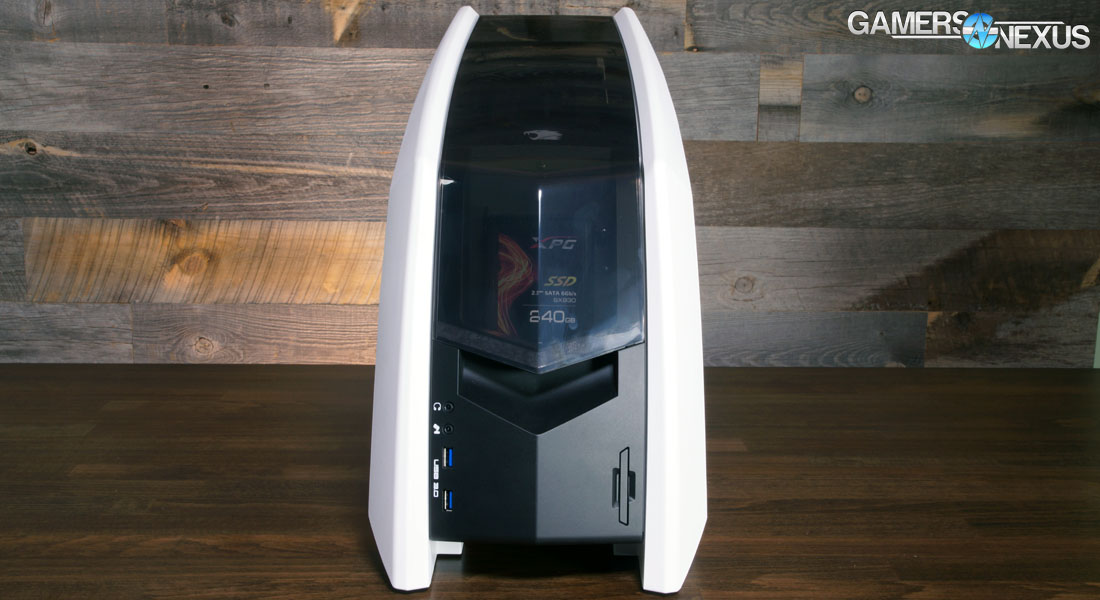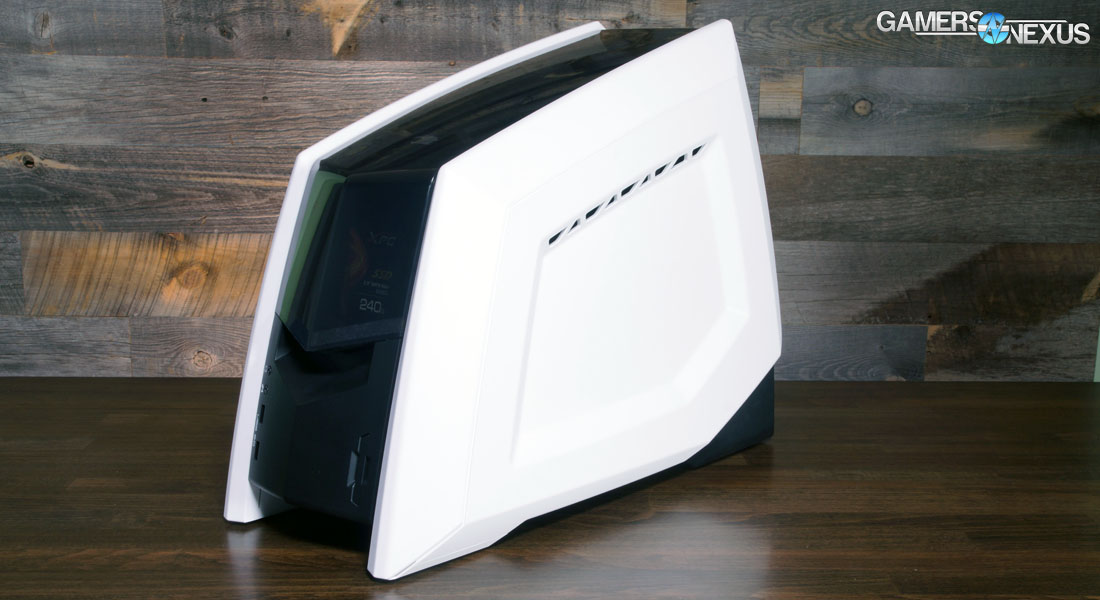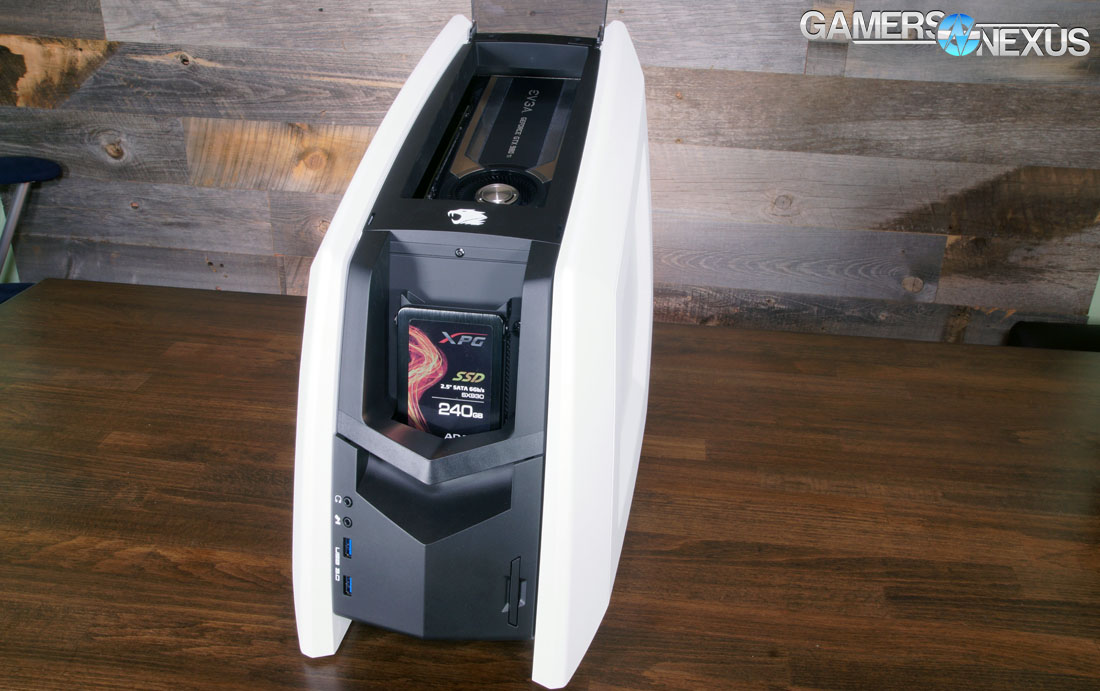SSD and GPU faceplates are often put front-and-center by case modders, perhaps despite manufacturers' best efforts to make ugly faceplates. System integrator (SI) iBUYPOWER recently figured it'd bypass the modding and sell flashy cases direct-to-consumer, planting the faceplates behind an acrylic window that lifts like a fighter plane's cockpit glass.
The new system and case amalgam, called the Revolt 2, tightly packs internals into a mini-ITX enclosure, using an inverted motherboard* to separate the GPU from the more thermally-constricted core components. We've got one on-hand for testing and intend to send the Revolt 2 through exhaustive thermal analysis, with a new focus on chipset and SSD thermal measurements, but won't be doing that until after CES. For the time being, we'll walk through the Revolt 2's case and talk design and test targets for the review.
iBUYPOWER Revolt 2 Specs
| CPU | Intel i7-6700K |
| Memory | 16GB DDR4-2400 |
| Motherboard | MSI Z170I Gaming Pro AC |
| Video Card | EVGA GTX 980 Ti Hybrid |
| CLC | Corsair H55 |
| SSD | 240GB ADATA XPG |
| HDD | 2TB Unspecified (Hitachi or Seagate) |
| PSU | 850W Thermaltake 80 Plus Gold |
The above is our loaner review unit, as assembled by iBUYPOWER. Customer builds are to-spec, as usual with SIs, so the above is tunable within some 'rules' established by iBUYPOWER. Opting-in to the Revolt 2 case imposes a liquid cooling requirement on the CPU (we agree on this), will likely force a minimum spec GPU to make full use of the front window, and may have other min-spec requirements before full availability on the website.
The GTX 980 Ti Hybrid combination is fitting for a system prone to higher internal case temperatures, given its substantial lead over all competing cards on our bench.
The case is shaped sort of like a rhombus – it reminds me of Tassadar's helmet in StarCraft II – with the acrylic window dead-center. The window lifts to reveal the SSD and GPU which, in our build's case, is using a blower fan to ensure air is exhausted out the back of the case. iBUYPOWER pulls air in from the bottom, through the radiators, in a configuration that seems at first glance to be sub-optimal – but we're told that it performs best in testing. We'll validate this shortly and perform additional configuration testing for optimal cooling placement.
Because everything is liquid-cooled, the considerably restricted interior becomes less a thermal concern than would be the case in the standard shoebox SFF build. Hot air is exhausted out the back of the video card, dispatching VRM and VRAM heat, and pulled into the case through the radiators, then exhausted by the PSU fan (facing the motherboard). The PSU fan's placement should assist in ridding of rising chipset thermals when processing heavy HSIO loads, like those that would be generated from saturated USB and GbE configurations.
The case is undeniably sharp – its white is nearly reflective (but finished in matte) – and demands placement at the center of the attention-demanding living room setup. RGB LED smart lighting is included in the top of the case, illuminating the GPU's faceplate with the usual mix of rainbow or breathing lights. We're not big on talking about aesthetics on this site, the photos do that well, so our primary interest remains in thermals. That'll all be benchmarked soon enough.
As presented above, our loaner unit is “just under $2,000,” but the price hasn't been finalized yet. The case MSRP is somewhere in the $100 range, but additional considerations – like a more expensive motherboard, as is the case with mITX – will also affect unit pricing. Our understanding is that this case will not be available standalone at this time, but we're hoping that'll change for the DIY audience.
More forthcoming.
- Steve “Lelldorianx” Burke.
* = System does not use PCI-e riser cable, but rather an inverted motherboard layout.


